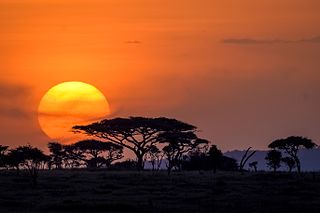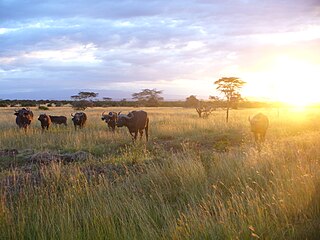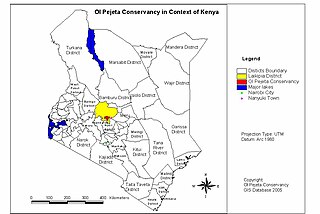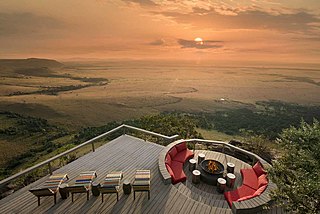| Founded | February 2001 |
|---|---|
| Focus | Environmentalism |
| Location | |
Area served | Mara Triangle |
| Website |
The Mara Conservancy manages the Mara Triangle, which is the northwestern part of the Maasai Mara National Reserve in Kenya.
| Founded | February 2001 |
|---|---|
| Focus | Environmentalism |
| Location | |
Area served | Mara Triangle |
| Website |
The Mara Conservancy manages the Mara Triangle, which is the northwestern part of the Maasai Mara National Reserve in Kenya.
In the year 2000 some of the local leaders became concerned about levels of mismanagement in the Mara Triangle. As a result, the Mara Conservancy, a not-for-profit management company, was established to manage the Triangle on behalf of Trans-Mara County Council.
A five-year management agreement was signed on 25 May 2001 and the Mara Conservancy started operations in the Mara Triangle on 12 June. This created the first public/private sector partnership of its kind in the region and has led to an active and cooperative partnership between conservation professionals and the local Maasai community. It has also introduced an initiative to improve the conservation and overall management of one of the most visited and well known protected areas in the world.

Maasai Mara, also sometimes spelled Masai Mara and locally known simply as The Mara, is a large national game reserve in Narok, Kenya, contiguous with the Serengeti National Park in Tanzania. It is named in honor of the Maasai people, the ancestral inhabitants of the area, who migrated to the area from the Nile Basin. Their description of the area when looked at from afar: "Mara" means "spotted" in the local Maasai language, due to the many short bushy trees which dot the landscape.

The Serengeti ecosystem is a geographical region in Africa, spanning northern Tanzania. The protected area within the region includes approximately 30,000 km2 (12,000 sq mi) of land, including the Serengeti National Park and several game reserves. The Serengeti hosts the second largest terrestrial mammal migration in the world, which helps secure it as one of the Seven Natural Wonders of Africa, and as one of the ten natural travel wonders of the world.

The Serengeti National Park is a large national park in northern Tanzania that stretches over 14,763 km2 (5,700 sq mi). It is located in eastern Mara Region and northeastern Simiyu Region and contains over 1,500,000 hectares of virgin savanna. The park was established in 1940.

The Mara River is a river in that begins in Narok County (Kenya) and in ends in Mara Region (Tanzania), and lies across the migration path of ungulates in the Maasai Mara/Serengeti ecosystem.

The Ngorongoro Conservation Area is a protected area and a UNESCO World Heritage Site located in Ngorongoro District, 180 km (110 mi) west of Arusha City in Arusha Region, within the Crater Highlands geological area of northern Tanzania. The area is named after Ngorongoro Crater, a large volcanic caldera within the area. The Ngorongoro Conservation Area Authority administers the conservation area, an arm of the Tanzanian government, and its boundaries follow the boundary of the Ngorongoro District in Arusha Region. The western portion of the park abuts the Serengeti National Park, and the area comprising the two parks and Kenya's Maasai Mara game reserve is home to Great Migration, a massive annual migration of millions of wildebeest, zebras, gazelles, and other animals. The conservation area also contains Olduvai Gorge, one of the most important paleoanthropological sites in the world.

Ngorongoro District is one of seven districts of the Arusha Region of Tanzania. The district is bordered to the north by Kenya, to the east by Monduli District, the northeast by Longido District, and to the south by the Karatu District. The western border is the Serengeti District in Mara Region. Ngorongoro District is home to the Ngorongoro Crater and was named after it. It covers an area of 14,036 km2 (5,419 sq mi). The district is comparable in size to the land area of Timor Leste. The administrative seat is the town of Loliondo. The district is home to the Ngorongoro Conservation Area which is a UNESCO World Heritage Site. According to the 2002 Tanzania National Census, the population of the Ngorongoro Region was 129,776. By 2012, the population of the district was 174,278.

Jonathan Scott is an English zoologist, wildlife photographer and television presenter specializing in African wildlife.

Mara Serena Airport is an airstrip in Masai Mara, Kenya.

Ocean Conservancy is a nonprofit environmental advocacy group based in Washington, D.C., United States. The organization formulates ocean policy at the federal and state government levels based on peer-reviewed science.

The wildlife of Kenya refers to its fauna. The diversity of Kenya's wildlife has garnered international fame, especially for its populations of large mammals. Mammal species include lion, cheetah hippopotamus, African buffalo, wildebeest (Connochaetes), African bush elephant, zebra (Equus), giraffe (Giraffa), and rhinoceros. Kenya has a very diverse population of birds, including flamingo and common ostrich.

The Coral Triangle (CT) is a roughly triangular area in the tropical waters around the Philippines, Indonesia, Malaysia, Papua New Guinea, the Solomon Islands and Timor-Leste. This area contains at least 500 species of reef-building corals in each ecoregion. The Coral Triangle is located between the Pacific and Indian oceans and encompasses portions of two biogeographic regions: the Indonesian-Philippines Region, and the Far Southwestern Pacific Region. As one of eight major coral reef zones in the world, the Coral Triangle is recognized as a global centre of marine biodiversity and a global priority for conservation. Its biological resources make it a global hotspot of marine biodiversity. Known as the "Amazon of the seas" (by analogy to the Amazon rainforest in South America), it covers 5.7 million square kilometres (2,200,000 sq mi) of ocean waters. It contains more than 76% of the world's shallow-water reef-building coral species, 37% of its reef fish species, 50% of its razor clam species, six out of seven of the world's sea turtle species, and the world's largest mangrove forest. In 2014, the Asian Development Bank (ADB) reported that the gross domestic product of the marine ecosystem in the Coral Triangle is roughly $1.2 trillion per year and provides food to over 120 million people. According to the Coral Triangle Knowledge Network, the region annually brings in about $3 billion in foreign exchange income from fisheries exports, and another $3 billion from coastal tourism revenues.
The Mara Triangle is the southwestern part of the Maasai Mara National Reserve, Kenya, and is managed by the not-for-profit organisation The Mara Conservancy on behalf of Trans-Mara County Council.
Tusk Trust is a British non-profit organisation set up in 1990 to advance wildlife conservation across Africa. The charity funds the protection of African elephant, African rhinoceros and African lion, along with many other threatened species across Africa. Tusk’s mission is to amplify the impact of progressive conservation initiatives across Africa.
The Shompole Conservancy is a large privately operated conservation area in the south of the Great Rift Valley, Kenya. It is located between Lake Magadi to the north and Lake Natron to the south, two alkaline lakes.
Olare Motorogi Conservancy is a 35,000 acre community-based conservation area in Kenya, part of the Maasai Mara-Serengeti ecosystem and wildlife dispersal zone. It borders the Maasai Mara National Reserve. It was founded in 2006 as part of a new community conservancy concept.

The Ol Pejeta Conservancy is a 360 km2 (140 sq mi) not-for-profit wildlife conservancy in Central Kenya's Laikipia County. It is situated on the equator west of Nanyuki, between the foothills of the Aberdares and Mount Kenya. The Ol Pejeta Conservancy works to conserve wildlife, provide a sanctuary for great apes, and generate income through wildlife tourism and complementary enterprises for re-investment in conservation and community development.

Mudumu is a National Park in Caprivi Region in north-eastern Namibia. The park was established in 1990. It covers an area of 737 square kilometres (285 sq mi). The Kwando River forms the western border with Botswana. Various communal area conservancies and community forests surround Mudumu National Park.

Angama Mara is a safari lodge in the Maasai Mara in Kenya. In the Kiswahili language, "angama" means "suspended in mid-air"; the name refers to the lodge's location 300 metres (980 ft) above the floor of the Maasai Mara.
To the east and north of the Maasai Mara National Reserve, some of the former Maasai cattle-grazing areas have been converted into wildlife conservancies for tourism.
Anita Soina is a Kenyan environmentalist by passion and also water and climate change advocate from the Maasai community. She is the author of the book Green War